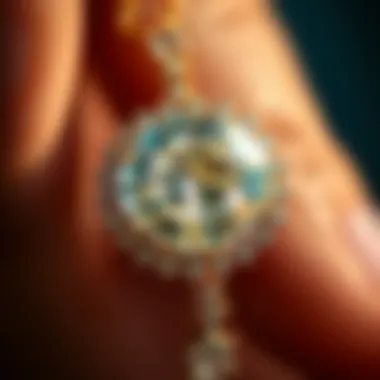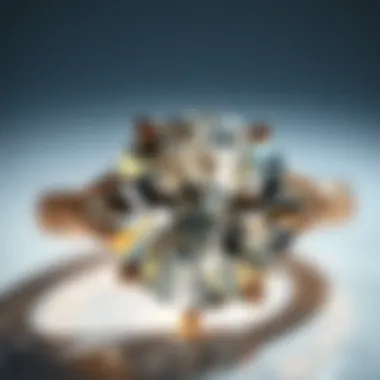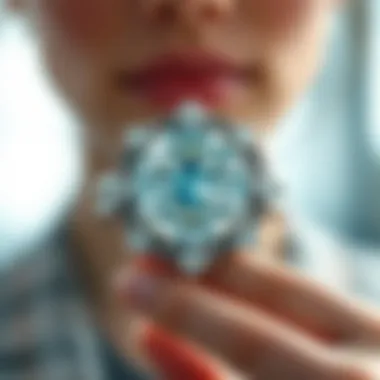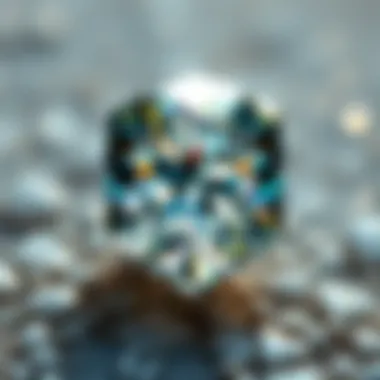Guide to Determine Genuine Diamonds: Key Tests & Tips


Intro
In a world where luxury and craftsmanship intertwine, diamonds often symbolize both love and wealth. Their allure captivates many, whether one is planning a significant purchase for an engagement ring or simply indulging a passion for collecting exquisite pieces. However, with the rise of synthetic diamonds and imitations, discerning the authenticity of these precious stones has become more critical than ever.
Understanding how to evaluate a diamond's authenticity is crucial for anyone looking to invest in or collect these dazzling gems. From the sparkle they emit to their intricate formations, diamonds are not just mere stones; they are a testament to nature's artistry.
This guide aims to equip you with the knowledge needed to navigate the often-confusing terrain of diamonds. We’ll explore various characteristics, practical tests, and the finer nuances, giving you the tools to ensure that every sparkling gem is truly what it appears to be.
Gemstone Overview
Definition of Gemstones
Gemstones come alive under the scrutiny of collectors and enthusiasts. Defined as natural or artificial minerals, gemstones undergo meticulous cuts and treatments, transforming them into objects of beauty and significance. Diamonds, as a subset of gemstones, are prized for their durability and radiance, making them the hardest known natural material.
Classification of Gemstones
Gemstones can be broadly classified into two distinct categories: precious and semi-precious. Traditionally, precious stones include diamonds, emeralds, rubies, and sapphires. These stones carry a higher value due to their rarity and aesthetic qualities. On the other hand, semi-precious stones, like amethysts and garnets, while beautiful and valuable, tend to be more abundant and therefore less costly.
- Precious Gemstones
- Semi-Precious Gemstones
- Diamonds
- Emeralds
- Rubies
- Sapphires
- Amethyst
- Garnet
- Peridot
- Topaz
By understanding these classifications, one gains insight into the market dynamics that govern diamond prices and appreciate the significance behind the different types.
Historical Significance
Origins of Gemstone Use
From ancient times, gemstones have been revered as symbols of status, power, and beauty. Archaeological discoveries show that people have been adorning themselves with gems for thousands of years, believed to possess mystical and healing properties. Their historical significance adds a layer of depth to their allure.
Cultural Insights: Gemstones in Ancient Civilizations
Throughout history, various cultures have placed great importance on gemstones. The Egyptians were known to engage in elaborate burial rituals, often including gemstones, which they believed would accompany the deceased into the afterlife. In ancient India, diamonds were often associated with royalty and the divine, making them highly sought after by kings and emperors.
"Gemstones are more than just minerals; they are reservoirs of history and reflections of human culture."
As we delve deeper into the analysis of diamonds and their authenticity, recognizing their rich past enriches the experience, sparking a deeper appreciation for these captivating jewels.
Prolusion to Diamond Authenticity
Understanding the authenticity of diamonds goes beyond mere fascination; it's a fundamental step for anyone investing in or admiring these precious stones. The world of diamonds is rife with intricacies, where a small oversight can lead to significant financial losses or unfulfilled expectations. Hence, diving into the nuances of authenticity not only benefits collectors and enthusiasts but also protects potential buyers from deceptive practices.
Understanding Diamonds
A diamond is not merely a shiny stone; it is a symbol of love, wealth, and sometimes, status. These exquisite gems originate deep within the Earth, formed from carbon under high pressure and temperature, and have undergone millions of years of natural processes to reach their polished form. The allure of diamonds lies in their rarity and unique properties that allow them to refract light in spectacular ways, giving them that unmistakable sparkle. However, the market is littered with both natural and lab-created diamonds, making differentiation crucial.
Being informed about what defines a genuine diamond can empower buyers. Their brilliance, clarity, and appeal can be easily assessed when one is equipped with the right knowledge. Basic traits like hardness and light dispersion are signatures of natural diamonds, whereas synthetic diamonds might fall short in some of these practical applications, despite their visual similarities.
Significance of Authenticity
When it comes to diamonds, authenticity carries weight far beyond a simple label it’s a matter of trust and assurance. The significant price differential between natural diamonds and their lab-grown counterparts can be staggering, so distinguishing the genuine from the counterfeit is paramount.
"Every diamond has a story; knowing its authenticity adds depth to its value."


In this sphere, authenticity signifies much more than just verification; it’s about the ethical implications and investment assurance. For example, natural diamonds often support local economies in various regions, relying on mining sectors that may employ local communities. Conversely, lab-created diamonds, while environmentally friendly, can sometimes lead to questions regarding market transparency.
Knowing the authenticity of a diamond can also bolster its resale value. A diamond with verified traits, recognized by reputable grading companies, will hold its worth better than an unverified one. Thus, understanding authenticity is a dual-edged sword: it enhances personal satisfaction in ownership and serves as an economic safeguard.
The Four Cs of Diamonds
When it comes to understanding diamonds, the Four Cs—Clarity, Cut, Color, and Carat Weight—are the cornerstone of evaluating their authenticity and overall quality. Each of these characteristics plays a crucial role in determining not just the beauty of the diamond but also its market value. Therefore, grasping these elements can empower both buyers and enthusiasts, transforming their approach to these exquisite gems.
Clarity of Diamonds
Clarity refers to the presence of internal or external flaws, known as inclusions and blemishes, respectively. The degree of clarity can significantly affect a diamond's beauty and value. A flawless diamond is exceptionally rare and often comes with a hefty price tag. However, many diamonds with minor imperfections can still exhibit stunning brilliance. The clarity scale ranks diamonds from flawless (FL) to included (I) based on these imperfections.
Understanding clarity deeply means knowing that even a gem with the slightest inclusions might shine just as brightly as its flawless counterpart. Enthusiasts should take note that usual identifying features can include:
- Pinpoints – Tiny black or white specks
- Clouds – Groups of tiny inclusions that might create a hazy effect
- Feathers – Breaks in the crystal structure that can appear like feathery patterns
To the discerning eye, these inclusions won't necessarily diminish the beauty of the stone. In fact, many collectors appreciate the character that these unique marks bring to a diamond.
Cut Quality
Cut quality refers to how well a diamond has been shaped and faceted. This characteristic substantially impacts how light interacts with the stone, elevating its sparkle and brilliance. A well-cut diamond can reflect and refract light beautifully, resulting in a dazzling display that captivates beholders. The cut ranges from excellent to poor, depending on the proportions and angles of the facets.
A diamond’s cut is not just about aesthetics; it determines how effectively it can shine. Factors to consider include:
- Symmetry: How well aligned the facets are
- Polish: The quality of the surface finish
- Proportions: How deep or shallow it is cut
Getting into the nitty-gritty of cut quality info can guide buyers in seeking a stone that not only meets their taste but also stands tall in the realm of brilliance.
Diamond Color
Diamond color grades range from colorless (which are highly sought after) to shades of yellow and brown. Practically, color can influence a diamond's appearance and value. Colorless diamonds are rare and skillfully trained gemologists can detect slight color variances in even what appears to be a pristine example. The grading scale typically starts from D (colorless) and goes to Z (light yellow).
Understanding the context around color requires a keen eye. Factors may include:
- Body color: The overall hue of the diamond
- Tint: Any visible shades that may alter its perception
- Influence from settings: Certain settings can enhance or mitigate color visibility
For those deep into the world of diamonds, identifying subtle shifts in hue can enhance their appreciation of the gemstone's unique beauty.
Carat Weight
Carat weight is a straightforward metric that measures the weight of the diamond. Many people may believe that a higher carat always results in higher value; however, that’s not the whole story. Carat weight affects appearance, but it must be considered alongside the other Cs. For instance, two diamonds weighing the same can differ markedly in value based on clarity and cut.
Key points to note regarding carat weight include:
- Size to weight relation: A diamond’s perceived size can vary.
- Cost per carat: Larger diamonds are increasingly rare, and their value escalates dramatically.
- Over-carats: Understanding that two smaller diamonds may combine to yield similar weight at a more favorable price.
In essence, the interplay between these characteristics significantly influences not only the diamond’s appearance but also its assessment in the marketplace.
By learning about the Four Cs and their implications, whether someone is a gem collector or simply a passionate admirer, they can make more enlightened choices in the dazzling world of diamonds, ensuring satisfaction and appreciation for their prized possessions.
Visual Inspection
Visual inspection serves as the first line of defense when trying to determine the authenticity of a diamond. It is an accessible method that requires no specialized tools or expensive equipment. This process involves a careful observation of the diamond's overall appearance and can often yield significant insights regarding its authenticity.
The benefits of visual inspection are manifold. For one, it requires minimal setup and can be performed almost anywhere, making it practical for buyers who may be viewing multiple stones in different locations. Additionally, when done correctly, visual inspection can provide immediate feedback on a diamond’s quality, helping potential buyers to quickly rule out synthetic stones that lack the natural beauty of a genuine diamond.


Using a Loupe
A loupe, or jeweler’s loupe, is a small magnifying glass that is commonly used in the industry to examine gemstones closely. By employing a loupe, one can scrutinize a diamond for specific internal and external features that are indicative of authenticity. When looking through a loupe, being attentive to the diamond's facets and surface is crucial.
Here’s what to consider during your inspection with a loupe:
- Clarity: Look for internal features, known as inclusions, which are natural to real diamonds. Synthetic diamonds often show fewer flaws.
- Blemishes: Surface imperfections can indicate that a diamond has encountered some form of damage or wear.
- Facet Reflection: The way a diamond reflects light can tell you a lot. Genuine diamonds will sparkle and refract light distinctively.
Using a loupe not only makes visual inspection easier but also allows for a more in-depth analysis of the diamond’s identity.
Identifying Blemishes and Inclusions
During the visual inspection process, pinpointing blemishes and inclusions plays a significant role. Real diamonds almost always contain some sort of natural imperfections—blemishes are surface flaws while inclusions are found within the stone. Understanding how to identify these factors can help differentiate between a high-quality diamond and a synthetic one.
- Blemishes can be scratches, nicks, or chips on the surface of the diamond. A clean surface can sometimes indicate a synthetic origin, as natural diamonds will typically have some form of these blemishes.
- Inclusions often take the form of tiny crystals or other elements trapped within the diamond during its formation deep within the Earth. Under a loupe, inclusions appear as small dark specks, clouds, or even color tints. The presence and nature of these inclusions can directly impact a diamond's value; more inclusions typically lower its worth.
Understanding these factors can empower buyers in their quest for genuine, authentic diamonds. Being able to discern when a diamond is less than perfect, yet still distinctly beautiful, becomes a skill worthy of any gemstone aficionado.
"In the world of gemstones, the less-than-perfect often holds the most beauty and value."
For those looking to deepen their knowledge further on this topic, resources such as Wikipedia and Gemological Institute of America can offer valuable insights and information.
Practical Tests for Authenticity
The Fog Test
The fog test is simple yet revealing. To perform it, hold your diamond between two fingers and breathe on it, much like fogging up a mirror. A real diamond dissipates fog almost instantly due to its superior thermal conductivity. Conversely, if the fog lingers for a few seconds, it’s likely a fake. This method doesn't require blingy gadgets, just your breath and a keen observation. The science behind this is compelling; real diamonds disperse heat quickly, while imitations trap moisture.
The Water Test
The water test is another straightforward assessment you can execute at home. Fill a glass with water and carefully drop your diamond in. Genuine diamonds possess a higher density than most fakes, so if the diamond sinks, it’s a good sign of authenticity. However, if it floats, you may be dealing with an imitation, like cubic zirconia, which tends to be lighter. That said, be cautious as this test doesn’t definitively prove authenticity but serves as a reliable initial assessment.
Light Reflection Test
Light plays a crucial role in a diamond's beauty. To examine its brilliance, take a closer look at how light interacts with it. Place your diamond under natural sunlight or a bright light source. Authentic diamonds sparkle with white and colored light due to their facet arrangement. If you notice a lack of sparkle or a cloudy appearance, this could mean it's not a legitimate diamond. A diamond should reflect a blend of brightness and colorful flashes, a dance of light that marks its authenticity.
Conductivity Test
Conductivity tests leverage the unique properties of diamonds. Diamonds are non-conductors of electricity, while many imitations are not. Using a diamond tester, you can measure the electrical conductivity of your stone. If you don’t have one, a simpler method is to press the diamond to your skin. If it feels cool and remains that way, it’s likely real. If it quickly warms up to body temperature, you might be holding a synthetic jewel. Conductivity tests are one of the more technical methods but can provide reliable results when used correctly.
"Choosing the right tests is essential in validating the authenticity of diamonds. Relying on multiple methods ensures thorough assessment and reduces risks."
Incorporating these practical tests into your diamond-buying journey can empower you with the knowledge to discern true value. Whether you’re a consumer or a casual enthusiast, these easy-to-execute assessments can lead to informed decisions. Remember, authenticity isn’t just about appearance; it's about knowing the value and integrity of what you hold.
Understanding Lab-Created Diamonds
In recent years, the discussion around diamonds has shifted significantly, particularly when it comes to the rise of lab-created diamonds. This topic is crucial for any gemstone enthusiast or potential buyer who is navigating the tricky waters of diamond authenticity. Lab-created diamonds are becoming increasingly popular, and understanding their characteristics provides vital insights for making informed decisions.
These diamonds are produced through advanced technological methods that replicate the natural conditions under which diamonds form in the Earth. The result is a stone that is chemically, physically, and optically identical to natural diamonds. This quality is what sets them apart and makes them a serious contender in the jewelry market. It's not merely a matter of aesthetics; it's about recognizing value and authenticity in the right context.
As demand for ethical alternatives grows, lab-created diamonds offer an appealing choice. Customers are increasingly motivated by factors like sustainability and ethical sourcing, which lab-created options provide. By shedding light on lab-created diamonds, this article helps potential buyers become educated about their choices, whether it's the classic sparklers from the earth or the precision-engineered gems from labs.
Distinction from Natural Diamonds
The line between lab-created and natural diamonds is blurred but crucial to understand. Natural diamonds are formed over billions of years deep within the Earth under extreme pressure and temperature. Their journey is long, and each diamond carries unique characteristics shaped by its natural environment.


Conversely, lab-created diamonds are synthesized in a fraction of that time. This can result in a significant price difference, often making lab-created diamonds more affordable. However, the distinction goes beyond just the means of creation:
- Authenticity: Natural diamonds often have a sense of history tied to their formation that lab-created diamonds lack.
- Rarity: Natural diamonds are finite and become increasingly rare, whereas lab-created diamonds can be produced as needed.
- Market Perception: There is still a significant perception gap. Many consumers equate authenticity with natural diamonds, which can impact resale value.
Understanding these distinctions is vital for anyone engaged in the diamond market, as it informs purchasing decisions and overall appreciation of both types of diamonds.
Pros and Cons
When weighing the options between lab-created diamonds and their natural counterparts, there are notable advantages and drawbacks to consider:
Pros of Lab-Created Diamonds:
- Cost-Effectiveness: Typically, lab-created diamonds can cost 20-40% less than natural diamonds. This means you might be able to afford a larger stone or a higher quality grade within your budget.
- Ethical Sourcing: Many buyers are drawn to lab-created diamonds due to the lesser environmental impact and the fact that their production does not involve labor exploitation.
- Identical Properties: Lab-created diamonds possess the same physical and optical properties as natural diamonds, ensuring that they sparkle just as brilliantly.
Cons of Lab-Created Diamonds:
- Resale Value: Generally, lab-created diamonds do not hold their value as well as natural diamonds, which can make them a less viable option for investment.
- Perception of Value: Some buyers may perceive lab-created diamonds as less desirable, impacting their long-term appreciation within certain markets.
- Limited History: While lovely, lab-created diamonds lack the storied history that many collectors and buyers value.
Understanding these pros and cons helps buyers make more informed choices that align with their values, whether that is affordability, sustainability, or emotional connection to the diamond.
"While the sparkle may shine the same, the stories behind diamonds can differ immensely"
Professional Appraisals
In the intricate world of diamonds, where each carat carries a distinct story, professional appraisals stand as beacons of trust. An appraiser’s expertise is not merely about assigning a monetary value; it’s about understanding the intricate details that authenticate a diamond’s identity. Sifting through layers of brilliance and clarity, these specialists bring nuances to light that a layman might miss.
Importance of Certification
Certification from a reputable gemological laboratory is a crucial element in the appraisal process. Such certificates act as a badge of honor, validating the quality and authenticity of a diamond. Without certification, buyers can feel like ships lost at sea, navigating through a murky world of counterfeit gems. This documentation often outlines essential characteristics like the Four Cs – clarity, cut, color, and carat – giving a crystal clear picture of what one is investing in.
- Authentication: Certificates guarantee that the diamond has gone through rigorous checking procedures.
- Value Assurance: Certified diamonds tend to maintain their value better; buyers have more confidence.
- Transparency: A certificate shows detailed information, which means no hidden surprises when you make your purchase.
When you look at a diamond that boasts a certification from a respected lab, you can be assured that it has been scrutinized by professionals. Institutions like the Gemological Institute of America (GIA) and the International Gemological Institute (IGI) are considered gold standards in this field. As a savvy buyer, it’s wise to seek a certificate from these entities, as this will save you a world of trouble further down the line.
"A certified diamond is like a well-paved road; it ensures a smooth journey in a marketplace often filled with potholes."
Choosing a Reputable Appraiser
Choosing the right appraiser is akin to finding a locksmith – you want someone who knows their stuff, can be trusted, and has a proven track record. Not all appraisers carry the same level of expertise or integrity, making it essential to do your homework. Here are some factors to consider:
- Qualifications: Look for appraisers certified by recognized organizations such as the American Society of Appraisers or the National Association of Jewelry Appraisers. Their training equips them with a keen eye for details.
- Experience: An appraiser with years of experience under their belt often sees beyond the surface. Their insight can identify telltale signs of authenticity or forgery that newer appraisers might overlook.
- Reviews and Referrals: Word of mouth can be invaluable. Seek testimonials from past clients or ask for recommendations. This way, you can learn from others’ experiences.
- Fee Structure: Understand how the appraiser sets their prices. Some charge by the hour, while others may have fixed rates. Always ensure you know what you are paying for.
- Personal Rapport: Feeling comfortable with your appraiser is key. A good appraiser should be willing to take the time to answer your questions and explain the evaluation process in layman's terms.
In essence, a professional appraisal not only provides peace of mind but also arms you with knowledge, significantly boosting your confidence in the diamond you’re buying or selling. Investing in diamonds should be a journey of passion, not one marred by doubt or deception.
End
The importance of assessing the authenticity of diamonds cannot be overstated. This article has delved into various facets of diamond evaluation, from the foundational characteristics of the diamonds themselves to practical methods for testing their genuineness. Understanding how to discern whether a diamond is real or synthetic is not just a matter of monetary investment; it’s fundamentally tied to the integrity of the jewelry industry and the trust that consumers place in the market.
Summary of Key Points
To summarize, several key points emerge as crucial when determining diamond authenticity:
- The Four Cs: Clear knowledge of clarity, cut, color, and carat weight equips buyers with a solid framework for evaluation. Each element plays a distinctive role in the diamond's overall value and appeal, and a thorough understanding of these characteristics helps assess authenticity effectively.
- Visual Inspection Techniques: Using tools like a jeweler’s loupe, buyers can detect blemishes and inclusions that might indicate a diamond's authenticity. This hands-on approach encourages a closer look and a more educated purchase decision.
- Practical Tests: Conducting practical tests, such as the fog test or the water test, can serve as initial evaluative measures. While these tests are not foolproof, they provide quick insights into the stone’s properties and can help differentiate between real and synthetic options.
- Professional Appraisals: The value of seeking expert evaluation cannot be minimized. Certified appraisers provide authoritative opinions backed by industry standards. Choosing a reputable appraiser ensures a trustworthy assessment, significantly aiding in making informed choices.
Final Thoughts
In an industry where authenticity affects everything from purchasing decisions to the emotional weight behind engagement rings, knowledge is power. It is vital for gemstone enthusiasts and potential buyers to arm themselves with both information and practical language that enables them to navigate diamond transactions with confidence. While the allure of diamonds remains strong, so does the need for due diligence in ensuring the legitimacy of each purchase.
"A well-informed buyer is often a satisfied one, navigating the world of diamonds with clarity and confidence."
For further reading, consider exploring resources such as Gemological Institute of America (GIA) or American Gem Society (AGS). These institutions offer extensive insights into diamond grading, authenticity, and industry standards.



